本文由Sasaki授权mooool发表,欢迎转发,禁止以mooool编辑版本转载。
Thanks Sasaki for authorizing the publication of the project on mooool, Text description provided by Sasaki.
Sasaki: 芝加哥河主干有着悠久且丰富的历史,它在很多方面呈现了芝加哥城市本身的发展。芝加哥河以前是一条蜿蜒的沼泽,后来被硬化改造为工程河道以支持城市向工业型转换。为了改善卫生情况,城市将河流主干与南边分支水流方向倒转,在此之后,建筑师与城市设计师丹尼尔·伯纳姆提出了滨河步道与瓦克道高架桥的新愿景。近十年来,河流所扮演的角色随着芝加哥滨河项目再次转换——重拾芝加哥河的城市生态与休闲效益。
Sasaki: The Main Branch of the Chicago River has a long and storied history that in many ways mirrors the development of Chicago itself. Once a meandering marshy stream, the river first became an engineered channel to support the industrial transformation of the city. Following the famed reversal of the river, in which the city reversed the flow of the Main Branch and South Branch to improve sanitation, architect and urban planner Daniel Burnham introduced a new civic vision of riverside promenades with the addition of the Wacker Drive viaduct. Over the last decade, the role of the river has been evolving with the Chicago Riverwalk project—an initiative to reclaim the Chicago River for the ecological, recreational and economic benefit of the city.
▼视频 Video
几年前,由于河流的重度污染,滨河休闲是遥不可及的目标。但今天这个愿景成为现实。在水质方面的最新进展以及沿河公共休闲使用强度的提升都体现了滨河生活的增加,呼唤通向水岸的新的连接。响应这些号召,芝加哥交通部开始实施滨河步道项目,用新空间充实系统的各个部分,其中包括非常成功的退伍军人纪念广场与沃巴什广场。
The goal of embracing the river as a recreational amenity seemed impossible years ago given the river’s high levels of pollution. But today that vision is becoming a reality. Recent improvements in river water quality and the increased intensity of public recreational use signal growing life along the river, demanding new connections to the water’s edge. Accordingly, the Chicago Department of Transportation and Ross Barney Architects led Phase One of the Riverwalk, an initial segment that includes Veteran’s Memorial Plaza and the Bridgehouse Museum Plaza.
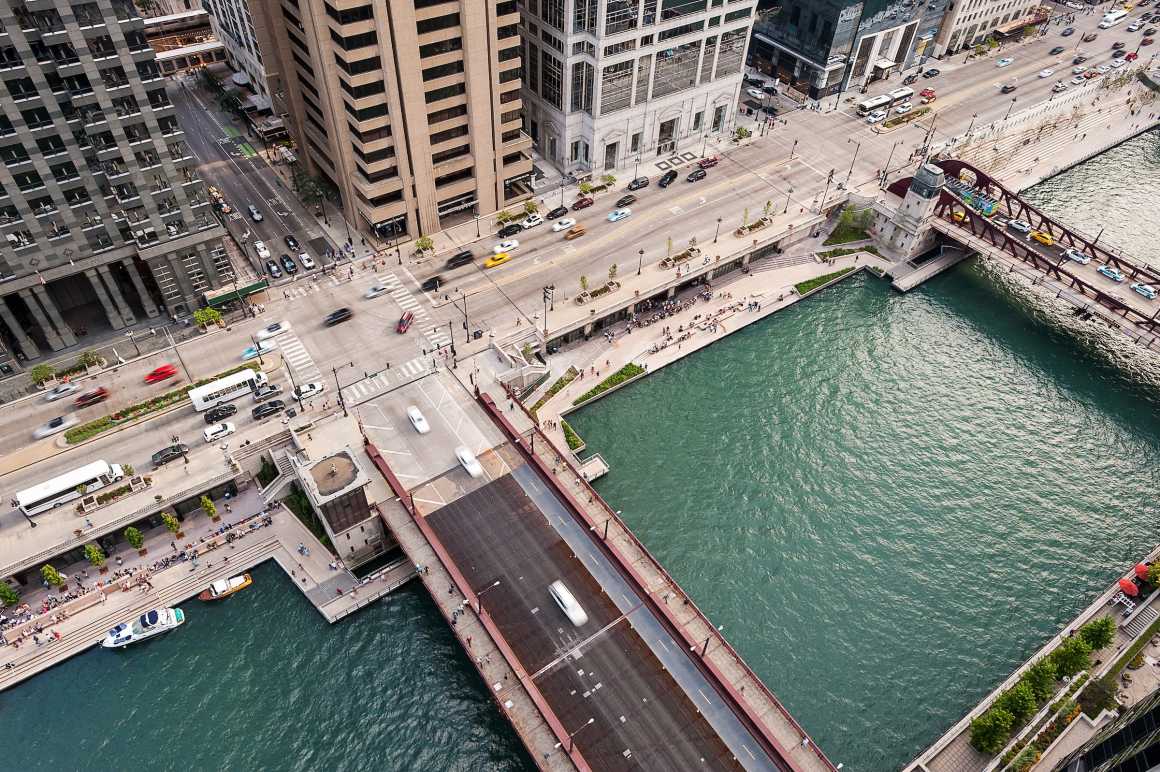
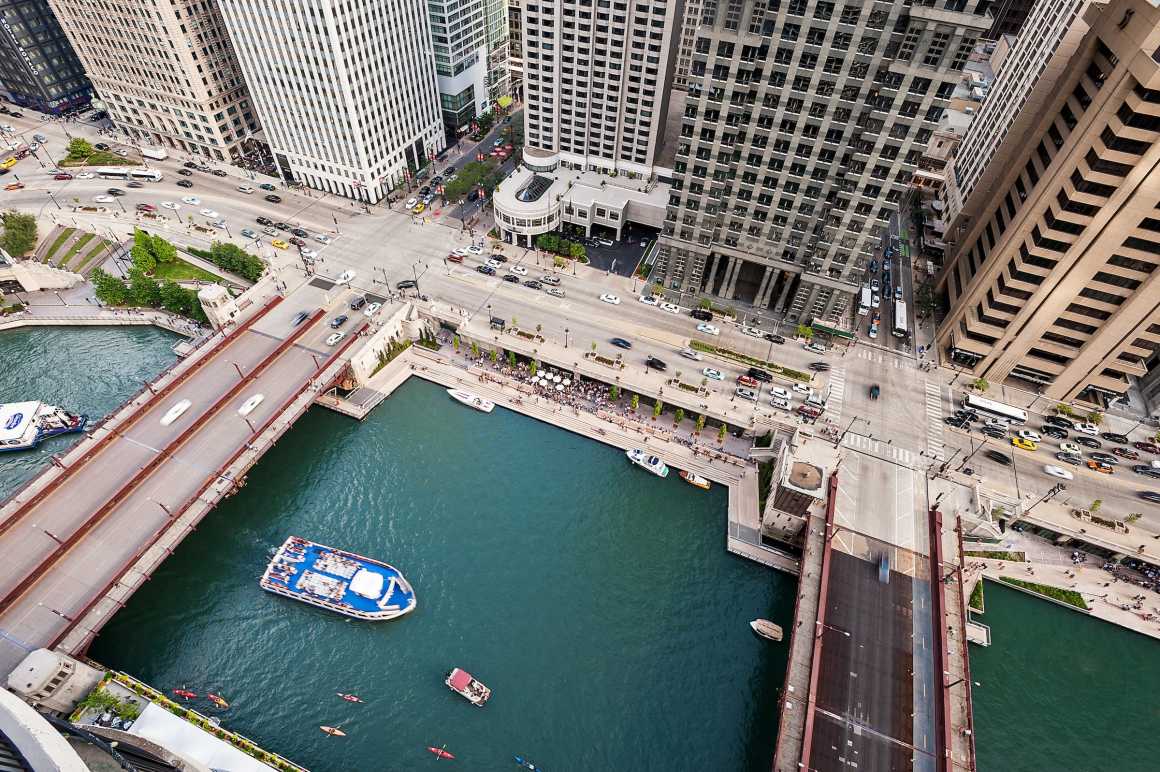
2012年,Sasaki、罗斯巴尼建筑事务所、阿尔弗雷德本纳什工程公司以及广泛的技术顾问团队合作,任务是为州街与湖街之间的六个街区创造愿景。在先前河流研究的基础上,此团队提出的芝加哥滨河概念规划在湖泊与城市步行系统,以及河流在城市中的支流之间提供了最后的关键连接。
In 2012, the team of Sasaki, Ross Barney Architects, Alfred Benesch Engineers, and Jacobs/Ryan Associates, supported by technical consultants, was tasked with completing the vision for Phases Two and Three: six blocks between State Street and Lake Street. Building off the previous studies of the river, the team’s plans provide a pedestrian connection along the river between the lake and the river’s confluence.
▼六种街区形态 Six blocks typologies
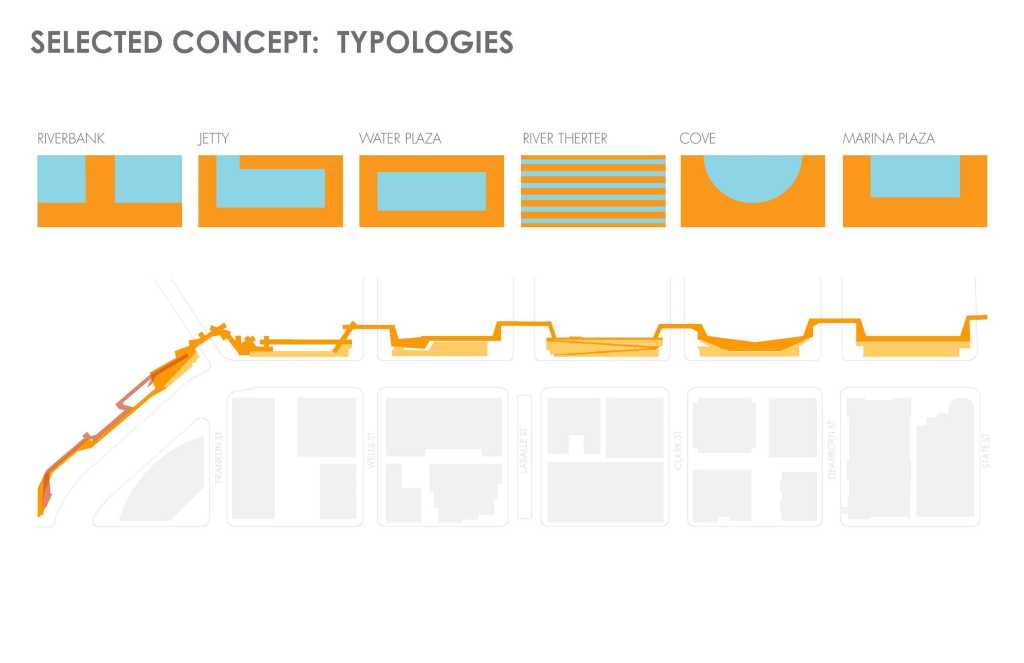
▼总平面图 Plan
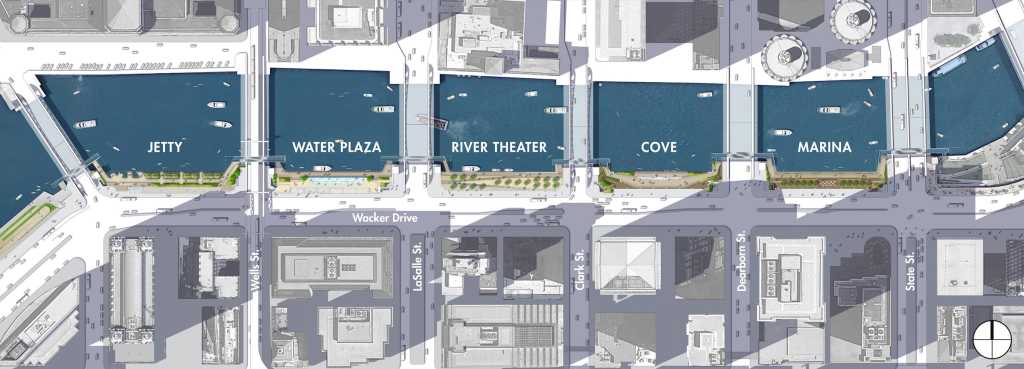
此任务在技术上面临极大挑战。设计团队需要在局限的7.6米宽的建成区扩展步行项目空间并与街区间一系列穿过桥下的区域协调。除此之外,设计还需要适应河流每年的洪水涨落,竖向高度差近两米。
将这些挑战变成机遇,团队为此线性公园提出了新的思路。取代以建筑为导向的充满直角拐弯的步道,将步道视为一个相对独立的系统——通过自身形态的变化,促进形成一系列与河相连的全新功能联系。新的连接使得滨河生活更加丰富多彩,每个街区都呈现出不同形态,代表以河流为基础的一种功能。
The task at hand was technically challenging. The design team, for instance, needed to work within a tight permit-mandated 25-foot-wide build-out area to expand the pedestrian program spaces and negotiate a series of under-bridge connections between blocks. Further, the design had to account for the river’s annual flood dynamics of nearly seven vertical feet.
Turning these challenges into opportunities, the team imagined new ways of thinking about this linear park. Rather than a path composed of 90-degree turns, the team reconceived of the path as a more independent system—one that, through changes in its shape and form, would drive a series of new programmatic connections to the river. With new connections that enrich and diversify life along the river, each block takes on the form and program of a different river-based typology.
▼码头广场区域平面 Marina Area Plan

码头广场:餐厅与露天座椅使人们可以观赏河流上动态场景,包括驳船航行、消防部门巡逻、水上的士和观光船。
The Marina Plaza: Restaurants and outdoor seating provide views of vibrant life on the water, including passing barges, patrols, water taxis, and sightseeing boats.
▼竖向高差近两米的场地 Nearly two vertical meters

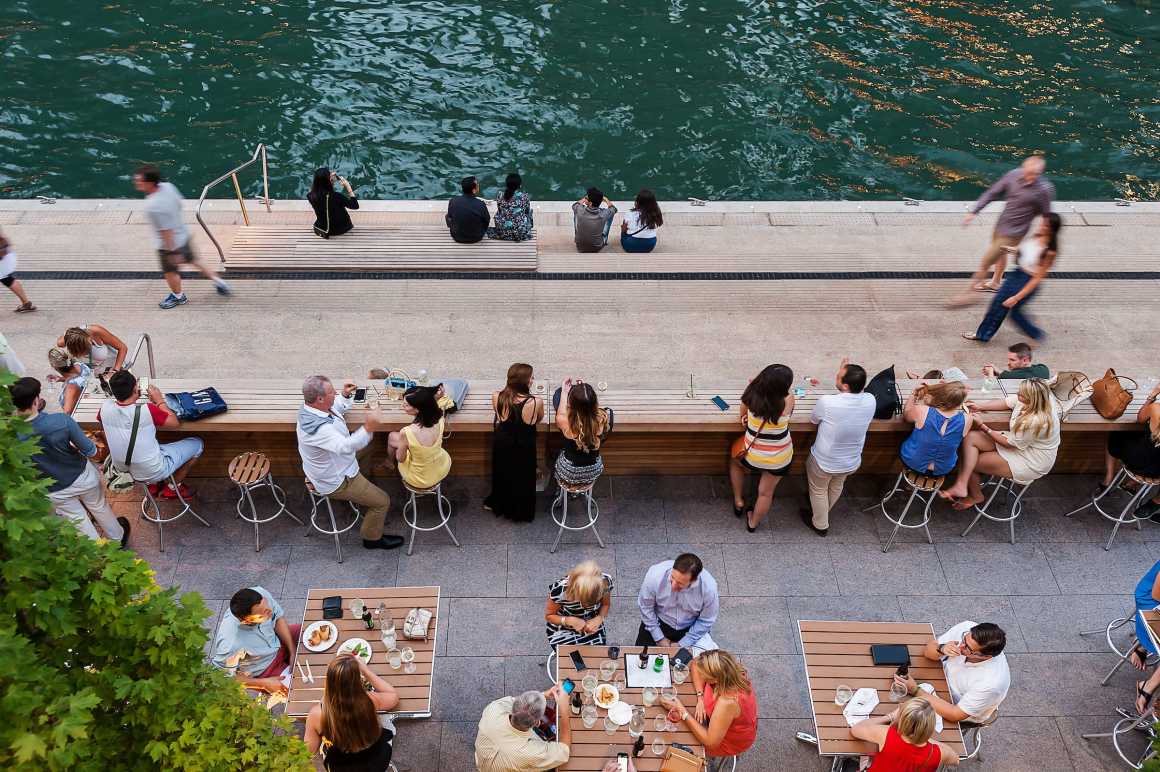



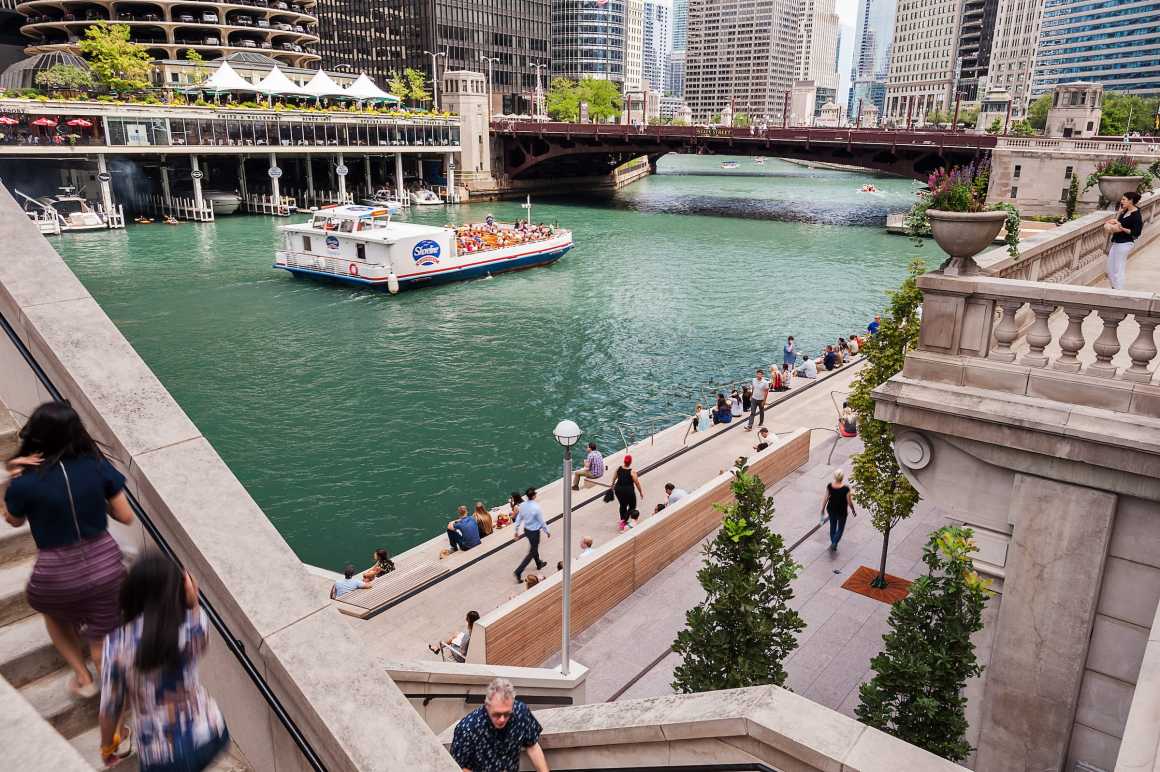

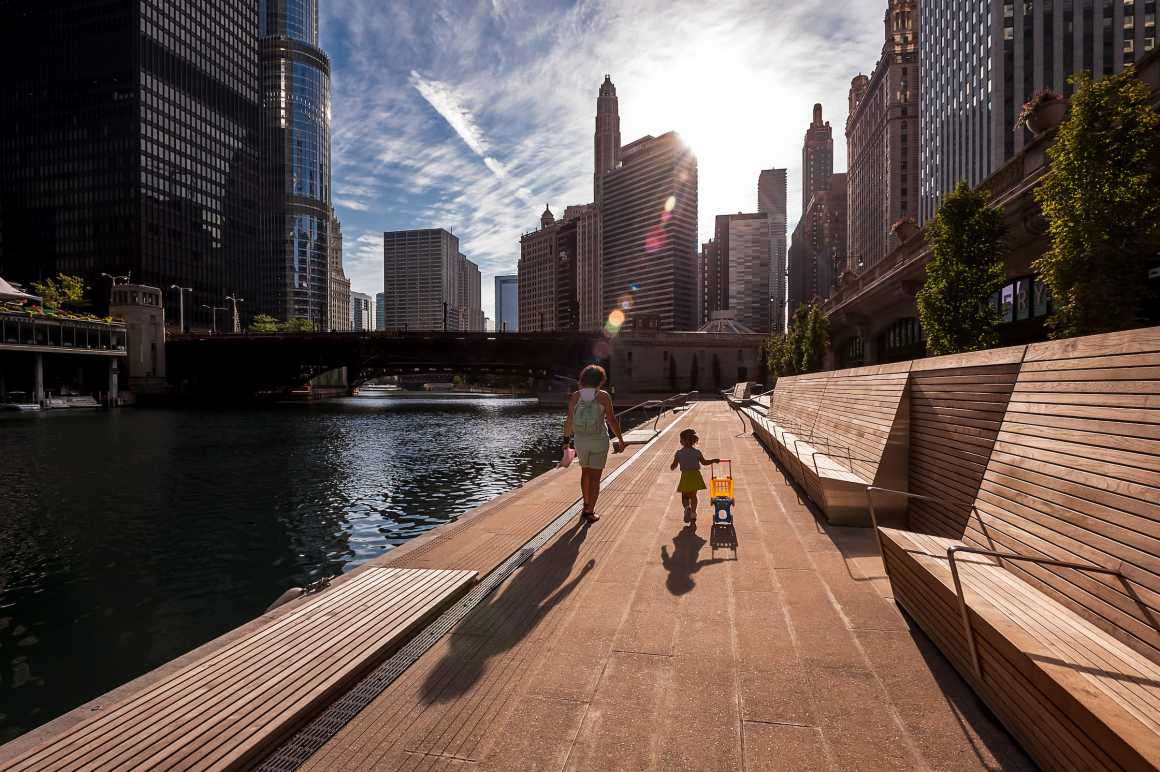
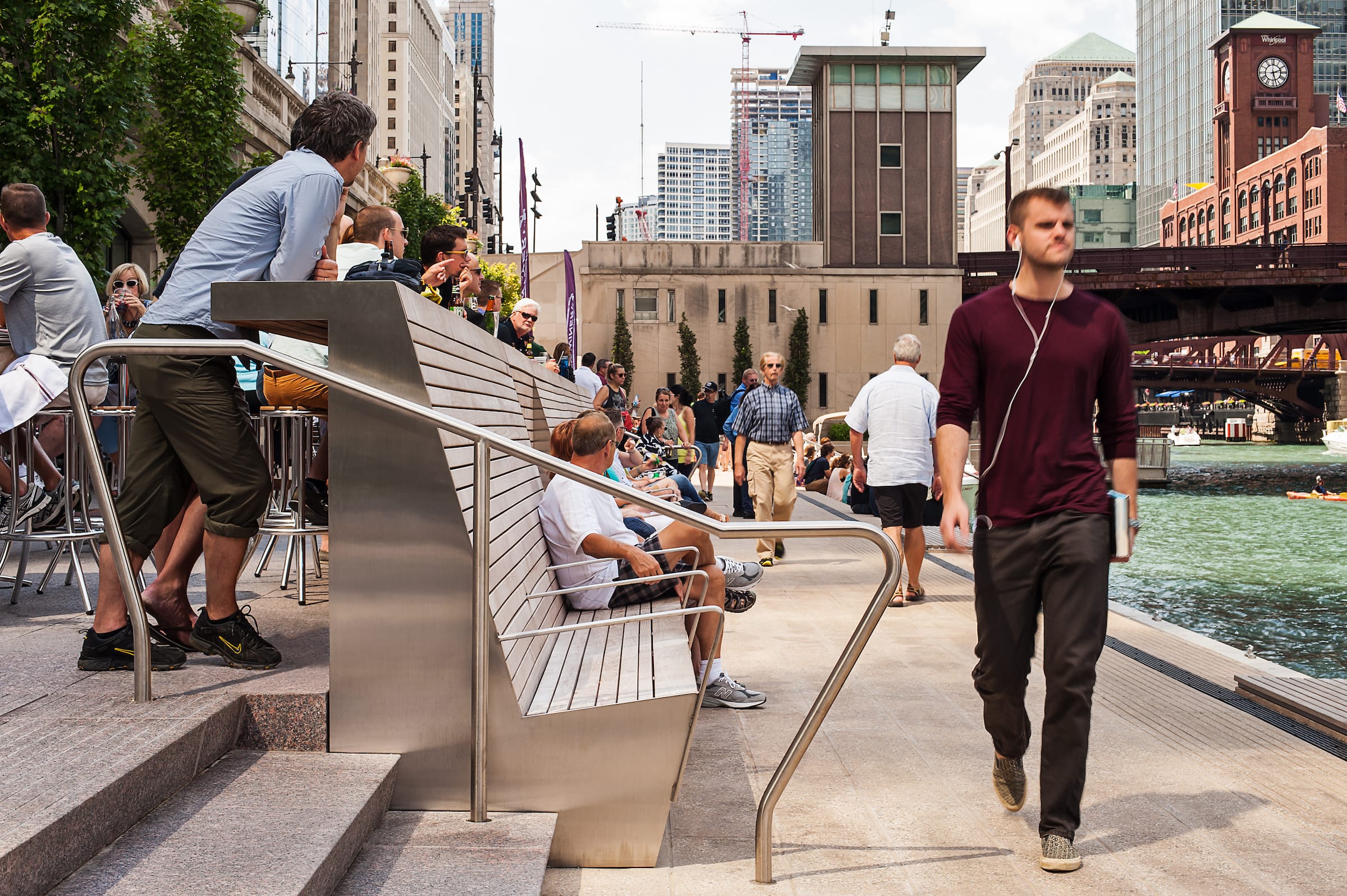
L&R: ©Christian Philips, Images Courtesy of Sasaki
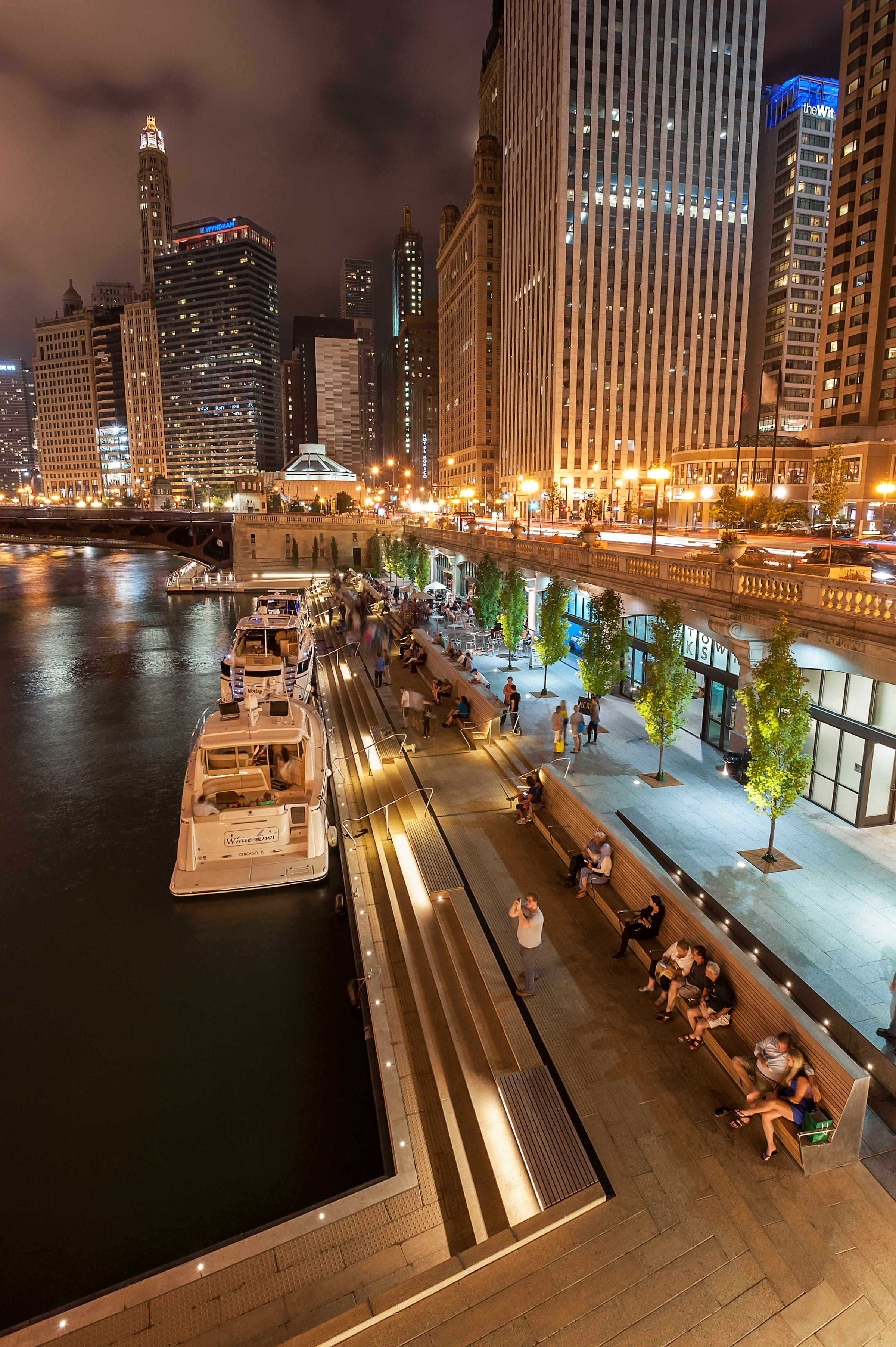
▼小河湾区域平面图 Cove Area Plan
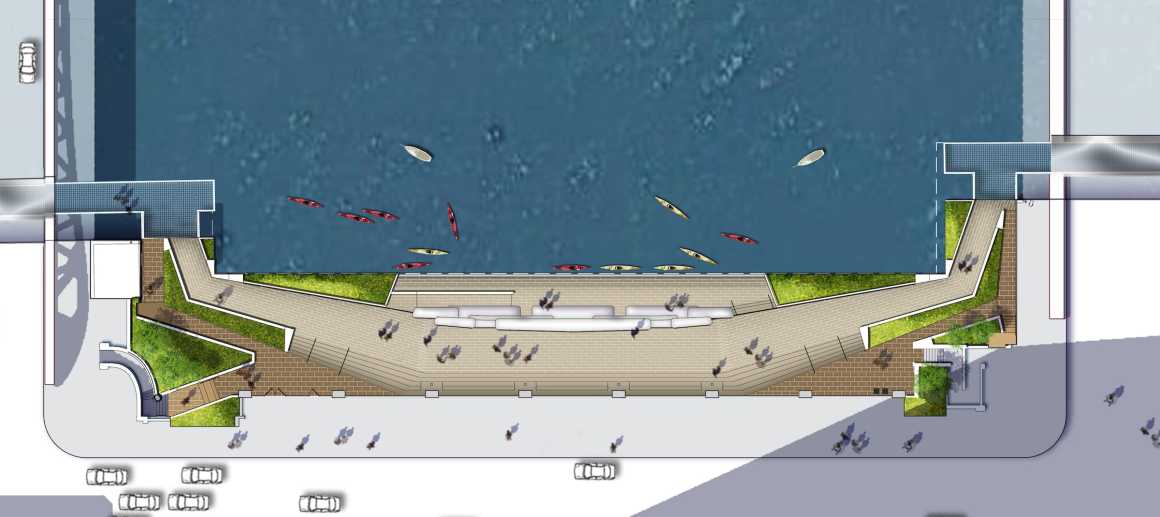
小河湾:租赁与存放皮划艇与独木舟, 通过休闲活动将人与水真切地联系起来。
The Cove: Kayak rentals and docking for human-powered crafts provide physical connections to the water through recreation.
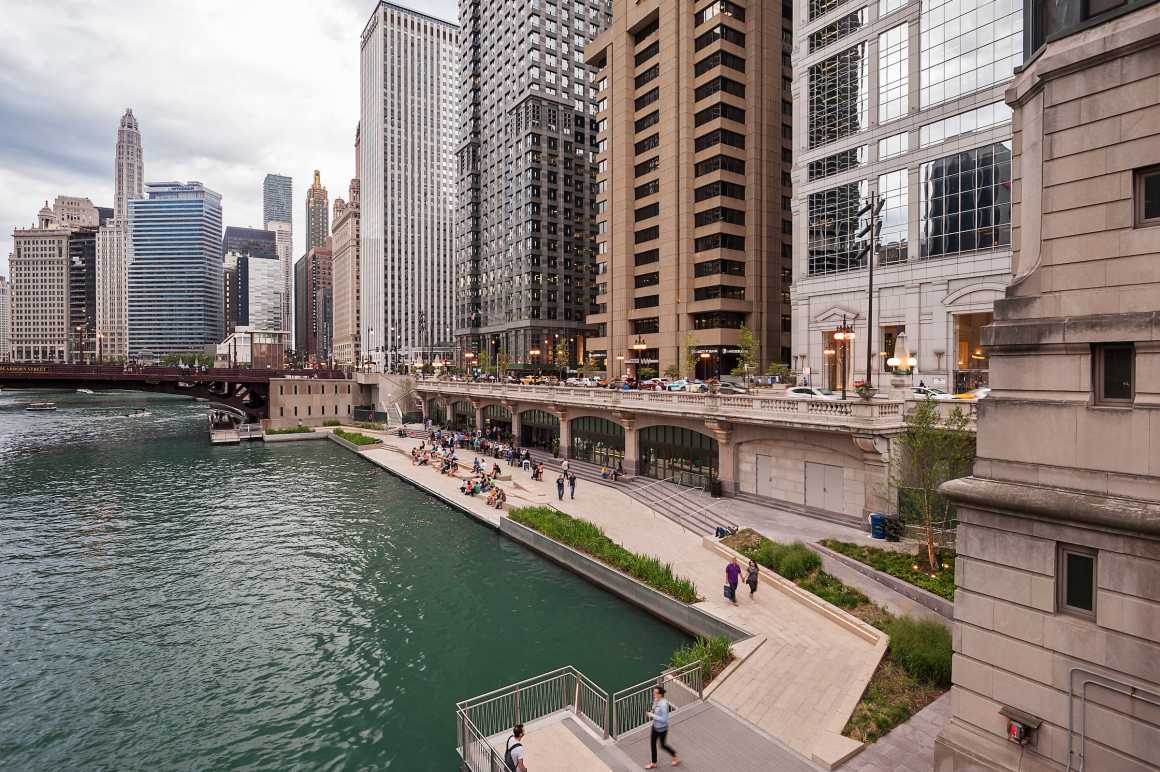
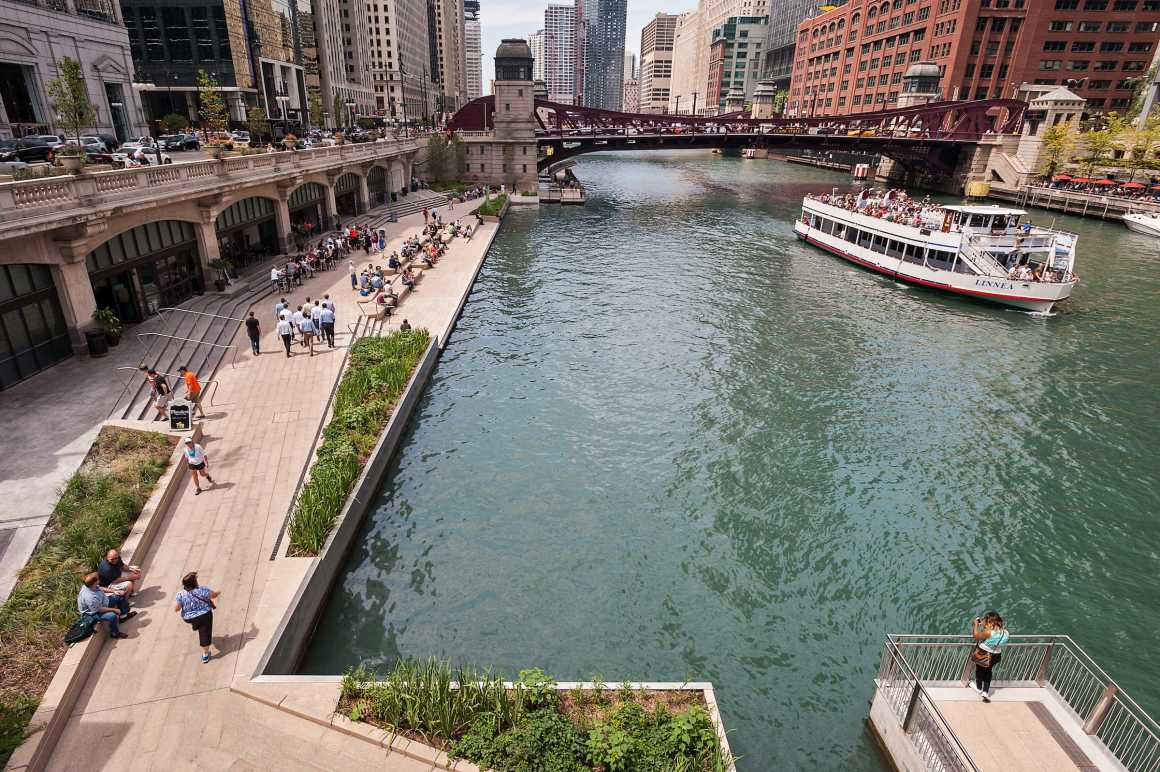
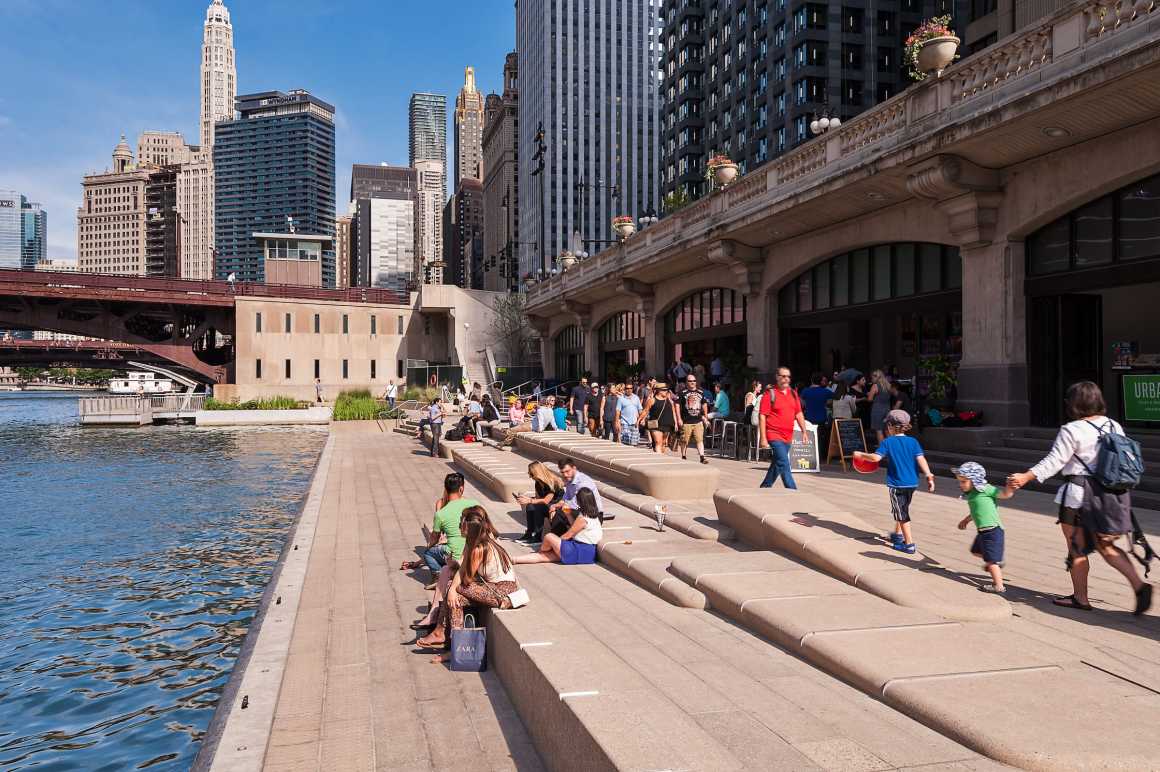
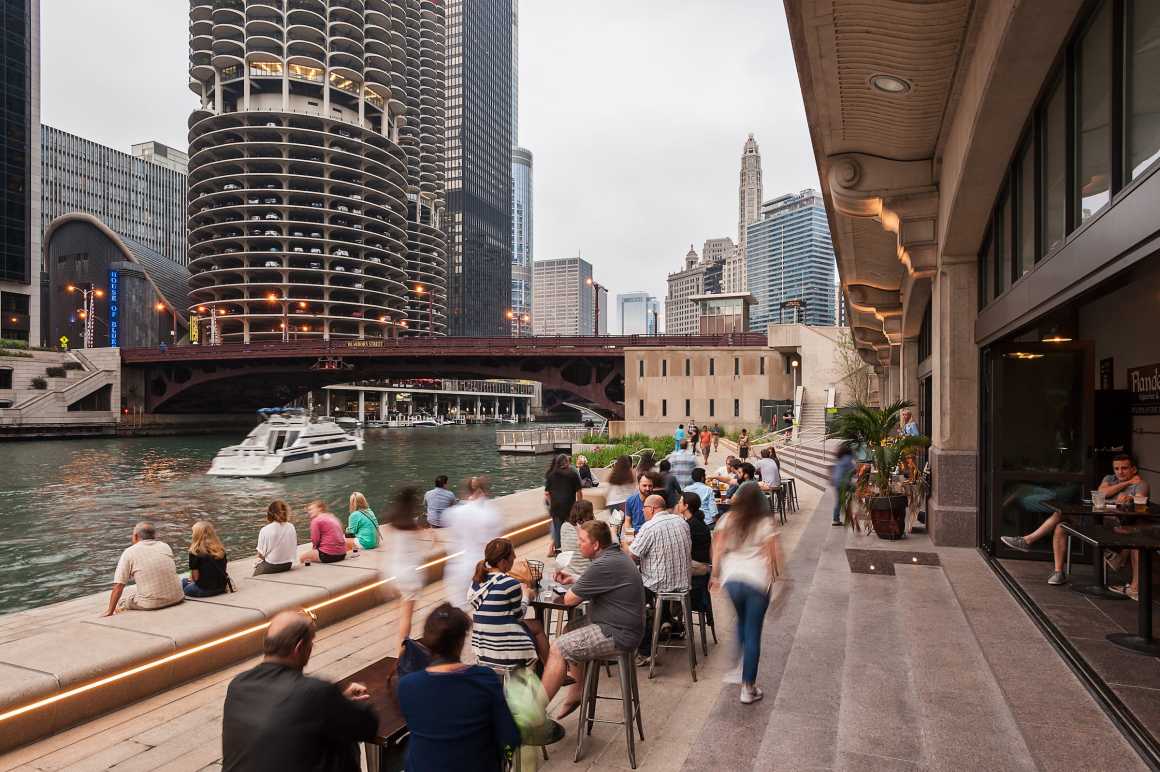

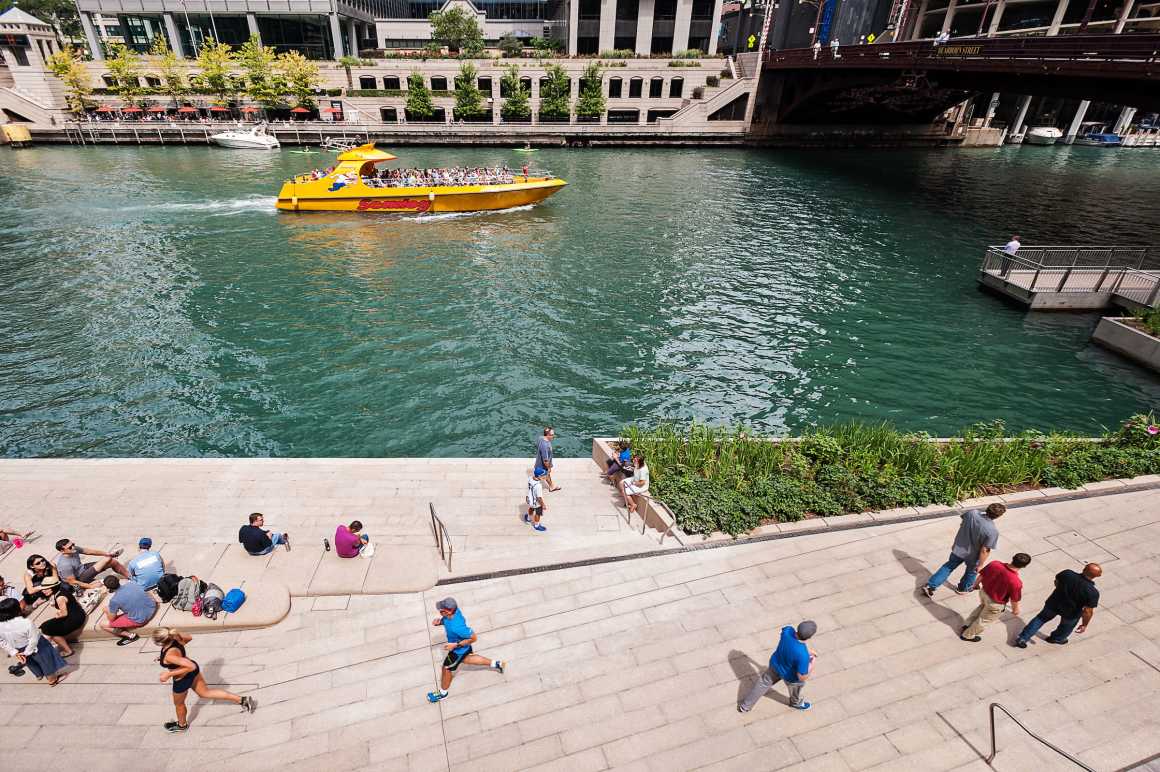
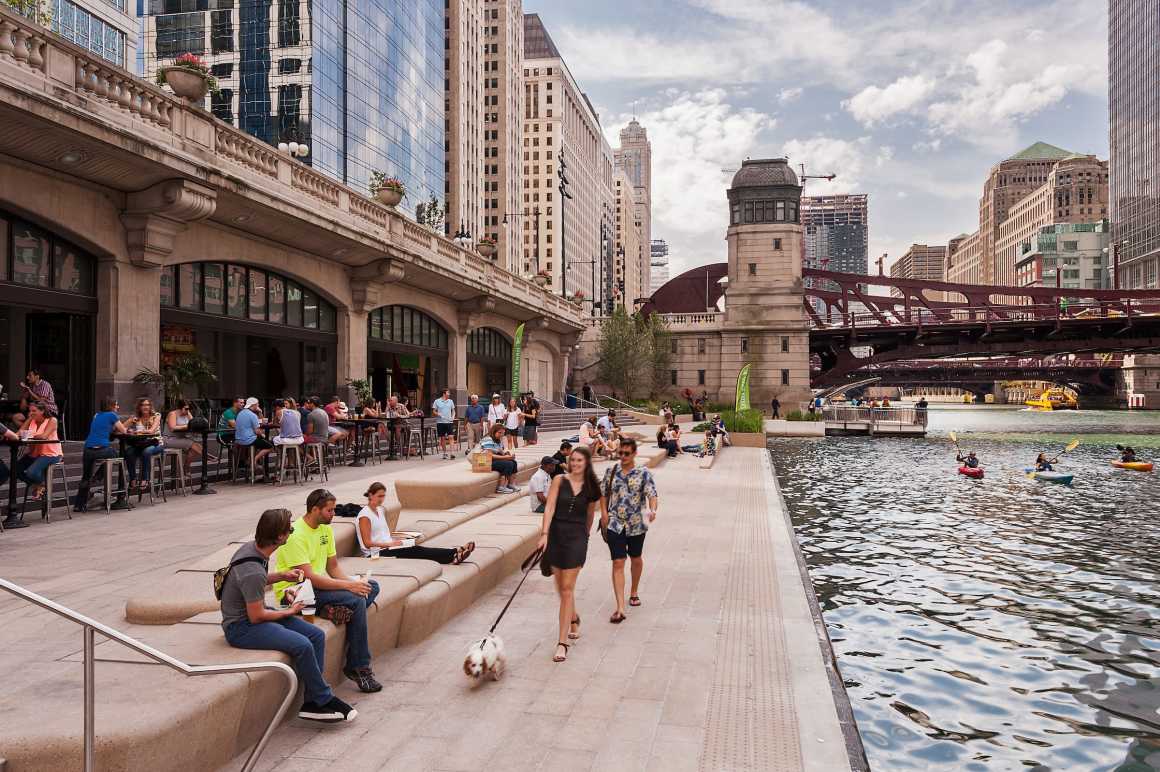
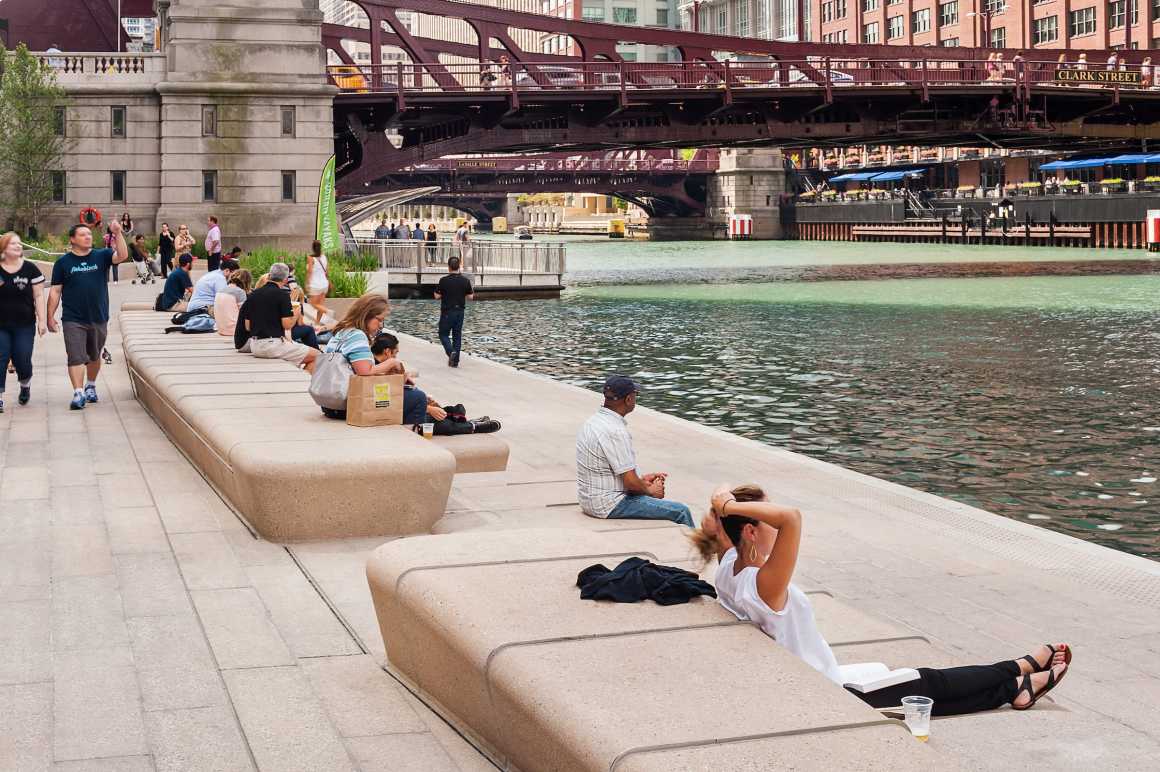
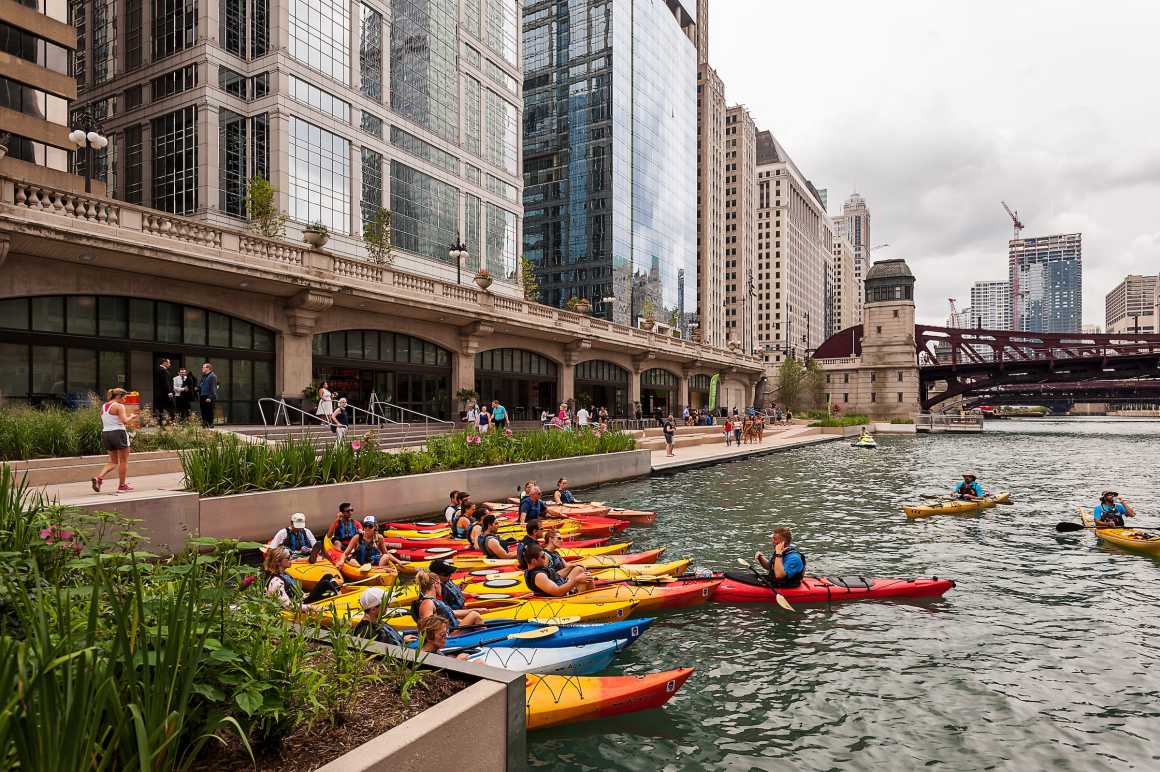
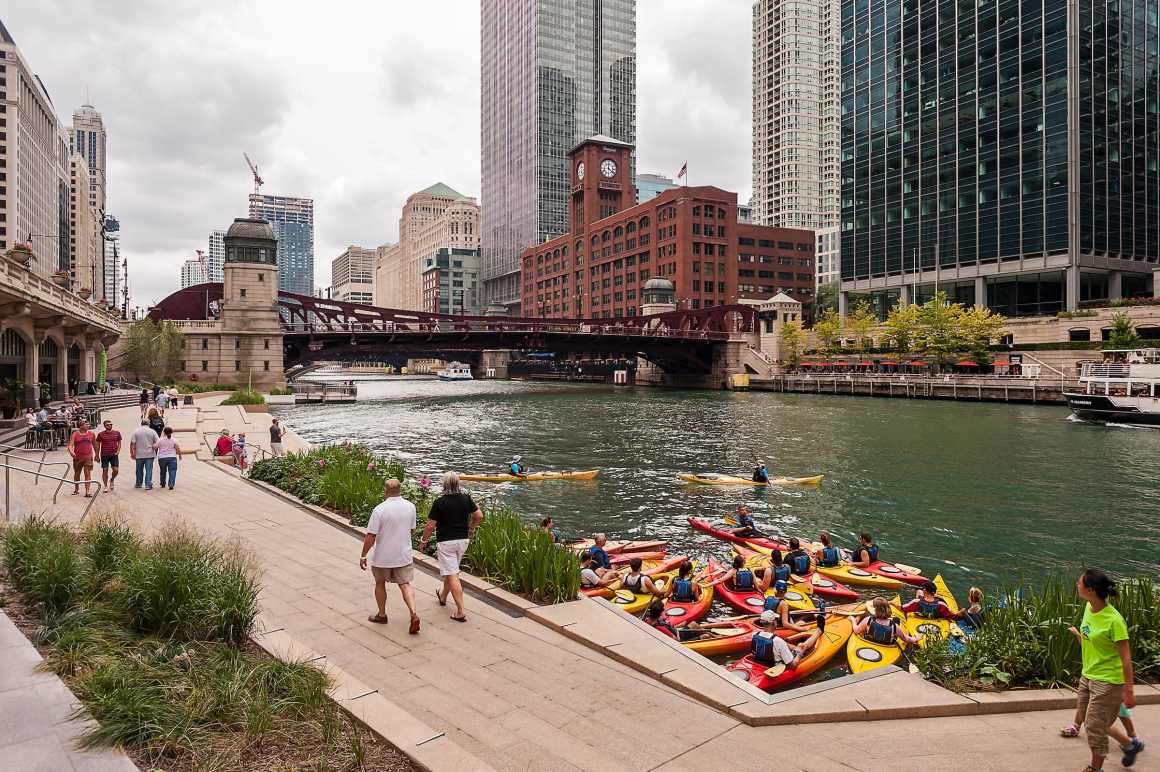
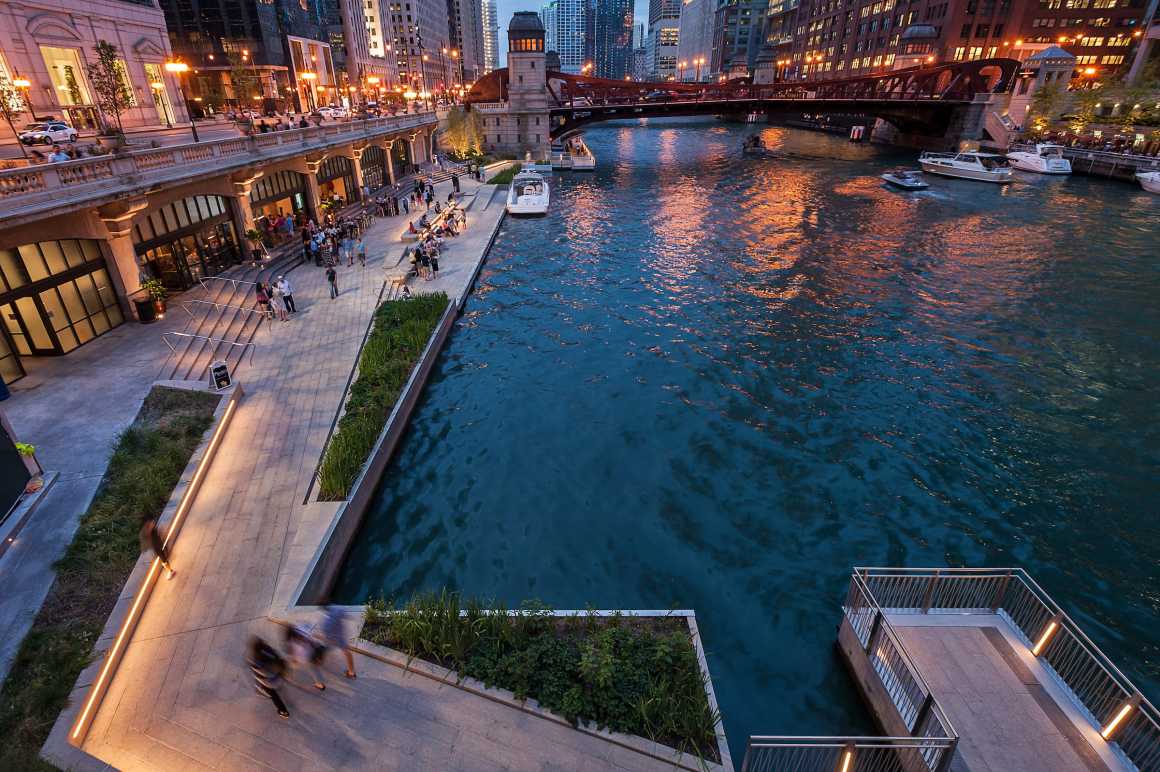
L&R: ©Christian Philips, Images Courtesy of Sasaki
▼河滨剧院区域平面 River Theater Area Plan

河滨剧院:连接上瓦克和河滨的雕塑般的阶梯为人们到达河滨提供了步行联系,周边的树木提供绿色与遮荫。
The River Theater: A sculptural staircase linking Upper Wacker and the Riverwalk offers pedestrian connectivity to the water’s edge and seating, while trees provide greenery and shade.
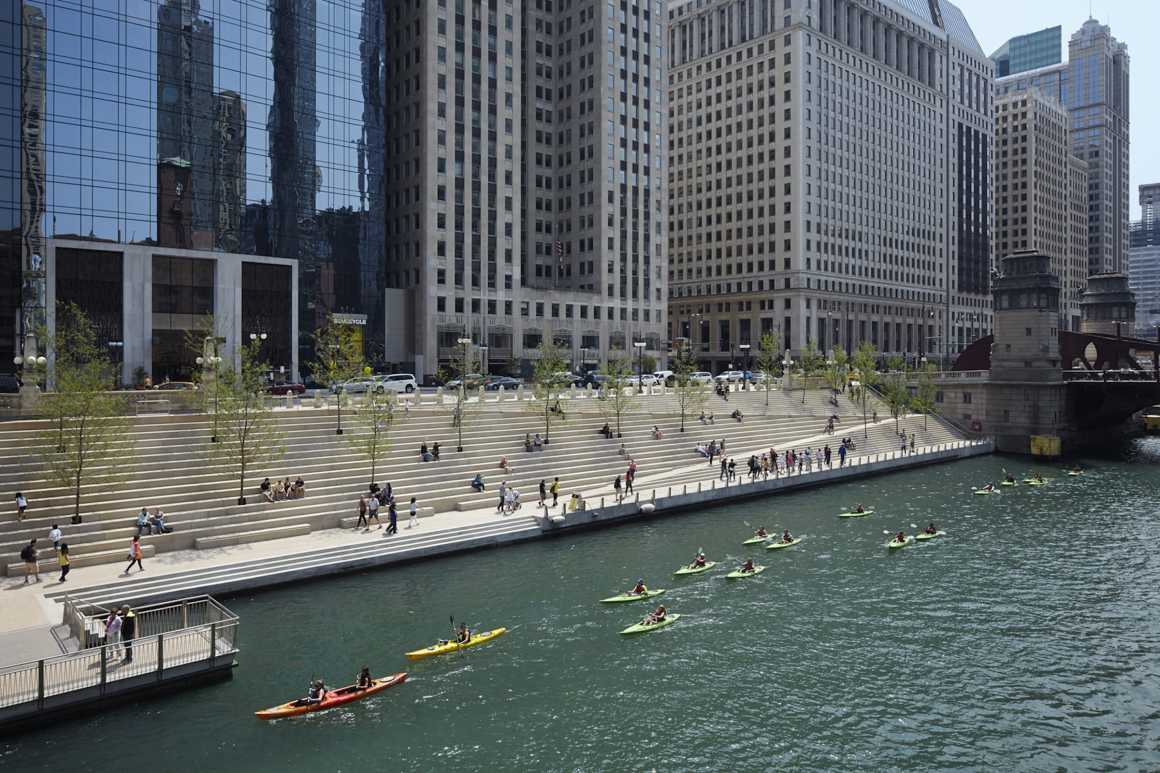
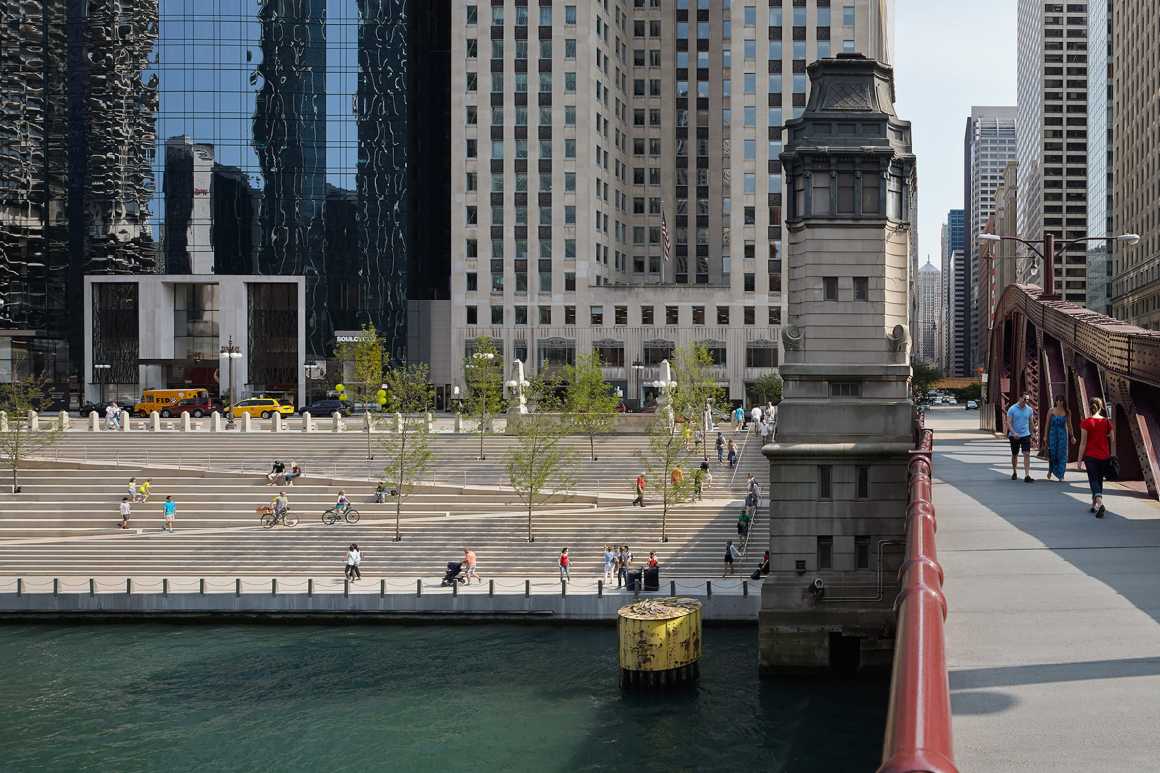
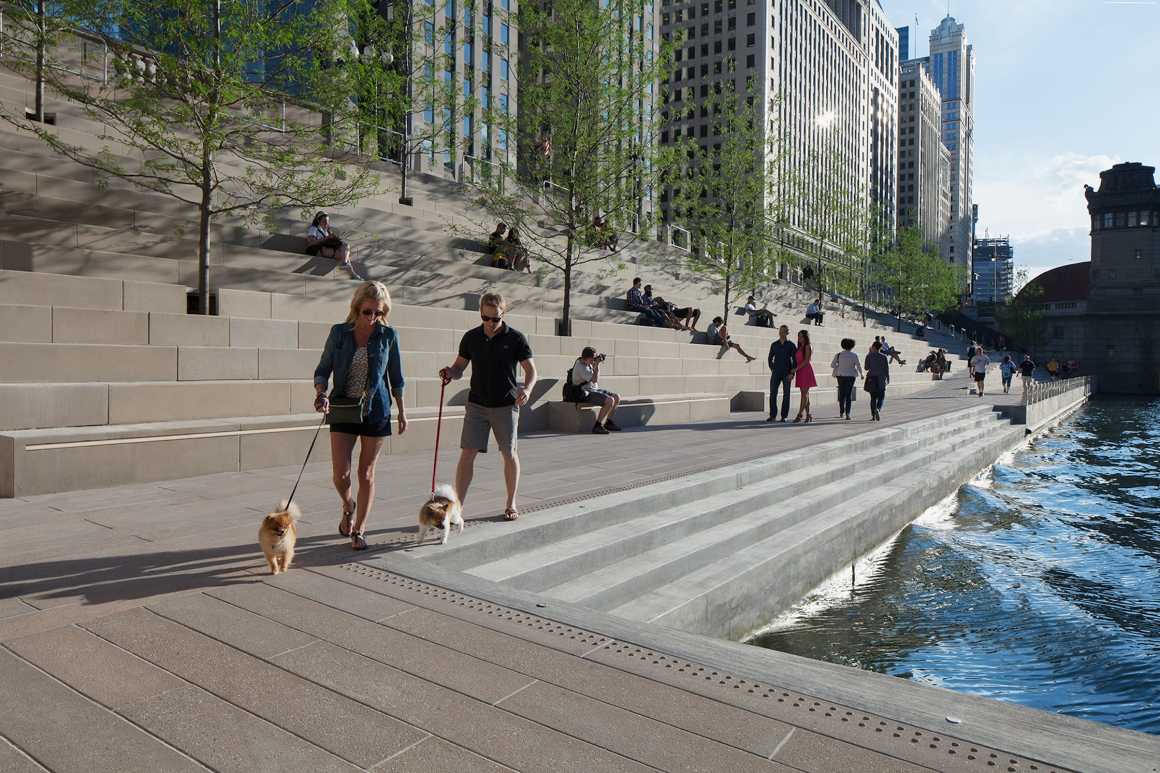
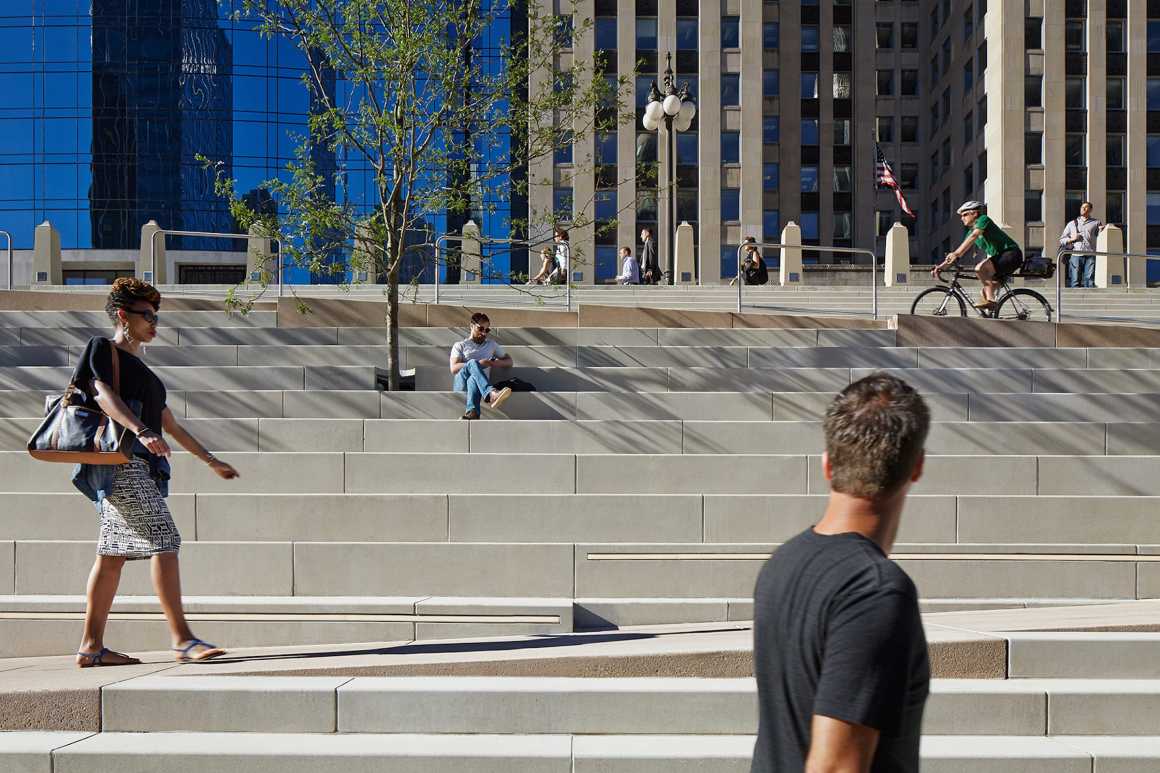

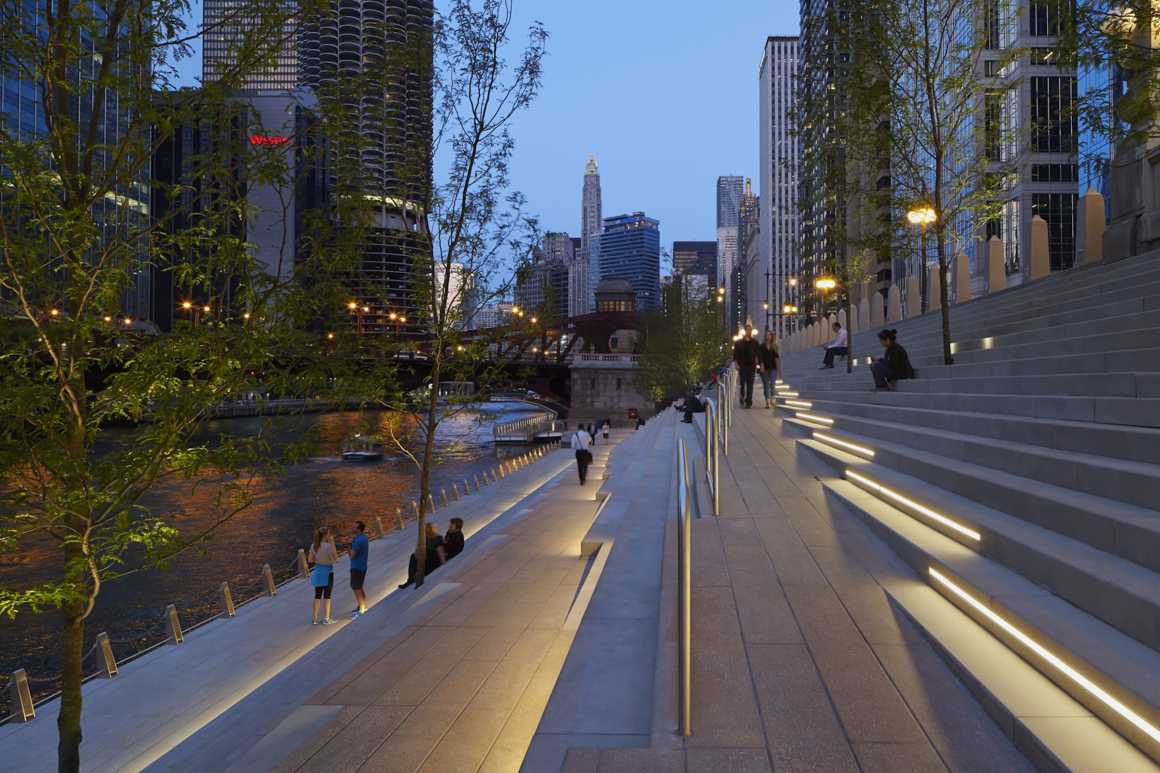
水广场:水景设施为孩子与家庭提供了一个在河边与水互动的机会。
The Water Plaza: A water feature offers an opportunity for children and families to engage with water at the river’s edge.
▼水广场平面图 The Water Plaza Plan
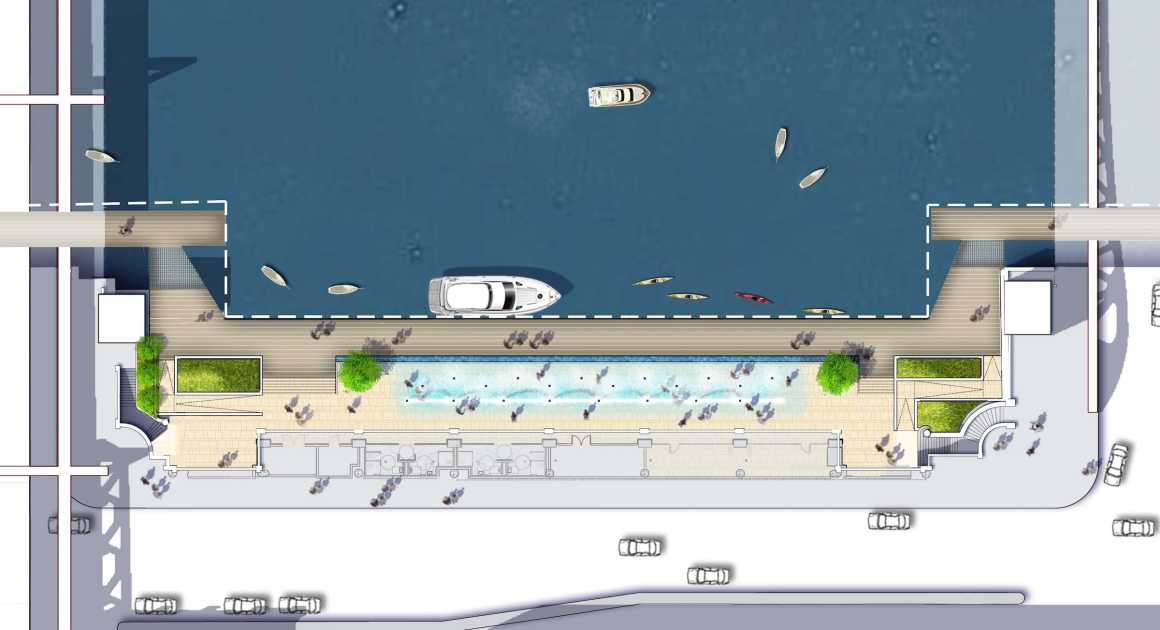
▼码头区域平面图 Jetty Area Plan
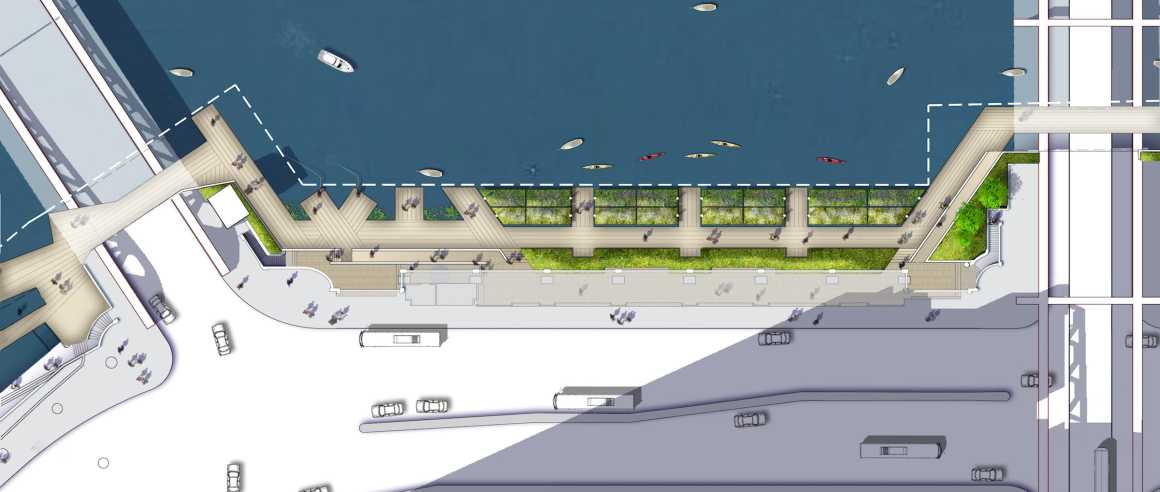
码头:一系列码头与浮岛湿地花园为人们了解河流生态提供了互动的学习环境,包括钓鱼与认识本土植物的机会。
The Jetty: A series of piers and floating wetland gardens offers an interactive learning environment about the ecology of the river, including opportunities for fishing and identifying native plants.

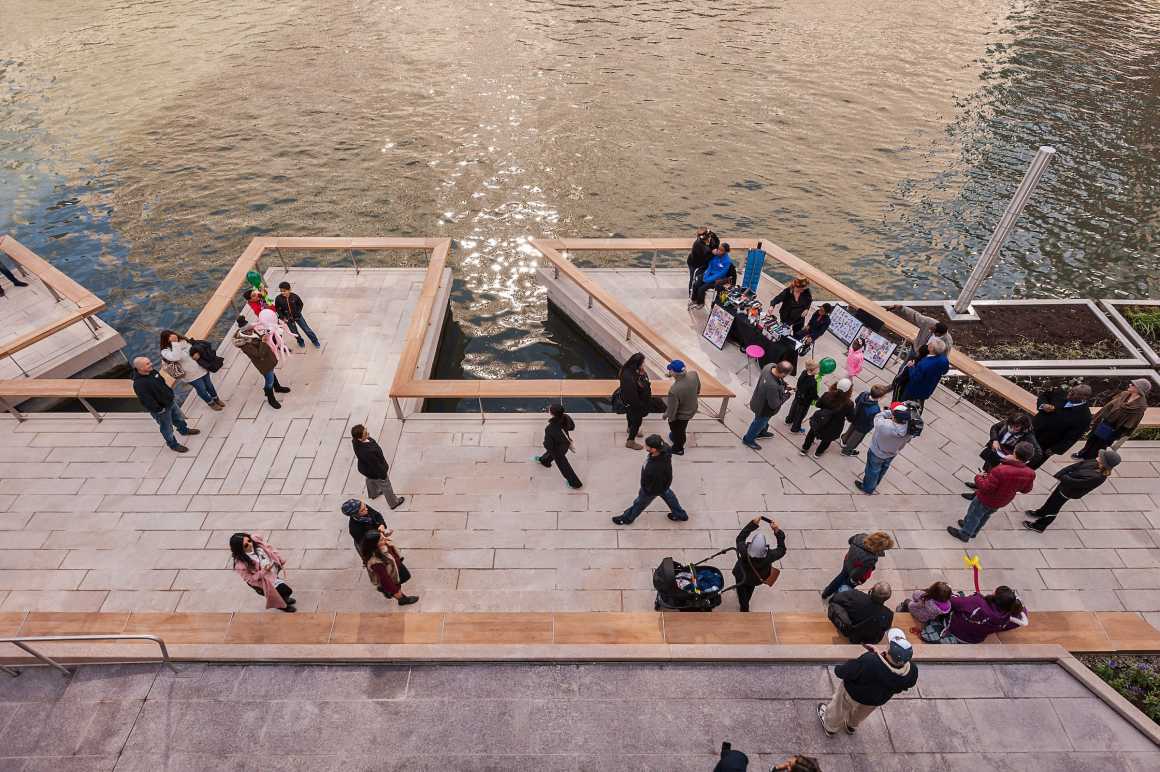
L&R: ©Christian Philips, Images Courtesy of Sasaki

河堤:无障碍步道与全新的滨水边缘创造出通向湖街的连续体验,并在关键的交叉路口为未来开发建立背景。
作为一个全新的联系步道系统,概念性规划框架为公园游客提供不间断步行体验。每个类型空间不同的功能与形态使它们可以提供滨河的多样体验,从餐饮、大规模公众活动,到全新划艇项目设施。同时,设计材料与细节沿整个项目长度提供视觉上的统一。例如,铺面体现背景现状的对比:精致的切石沿典雅的学院风格瓦克高架道路与桥屋建筑铺展开,而低层竖向与钢筋出露的桥梁下方由坚实的预制板环绕。
The Riverbank: An accessible walkway and new marine edge creates continuous access to Lake Street and sets the scene for future development in this critical space at the confluence.
As a new connected path system, the Chicago Riverwalk design provides both continuity and variety for a park visitor. The distinct programs and forms of each typological space allow for diverse experiences on the river ranging from dining opportunities to expansive public event programming to new amenities for human-powered craft. At the same time, design materials, details, and repeated forms provide visual cohesion along the entire length of the project. Paving, for instance, mirrors the contrasts of the existing context: A refined cut stone follows the elegant Beaux-Arts Wacker viaduct and bridgehouse architecture, while a more rugged precast plank flanks the lower elevations and underside of the exposed steel bridges.
码头区生态策略 Ecological strategy:
▼植物种植递进层次:耐淹植物 – 挺水植物 – 沉水植物 Inundation tolerant – Emergent – Submergent
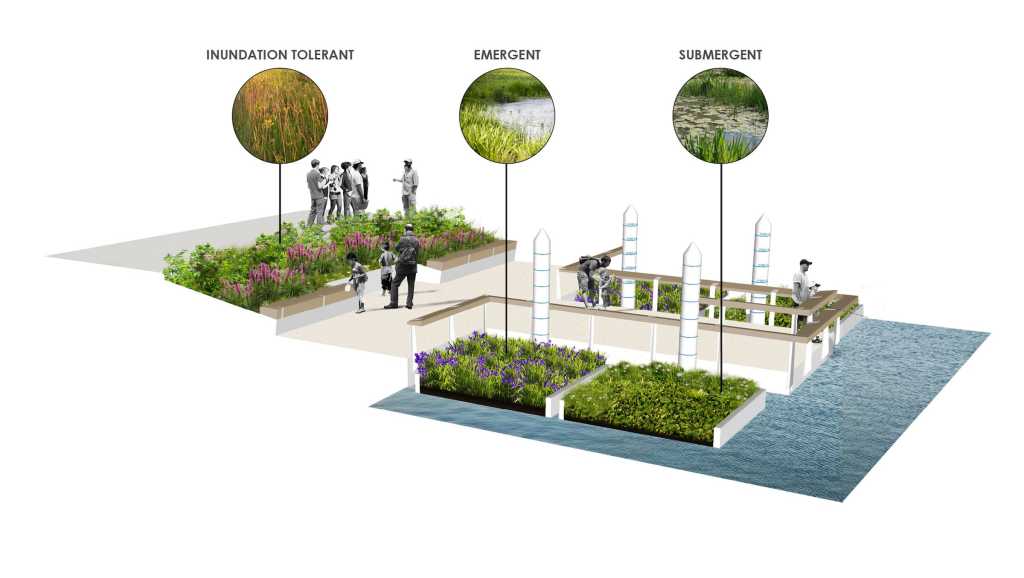
▼活动类型从户外学习课堂到水边的钓鱼活动 Areas for educational opportunity – Environmental graphics – Fishing


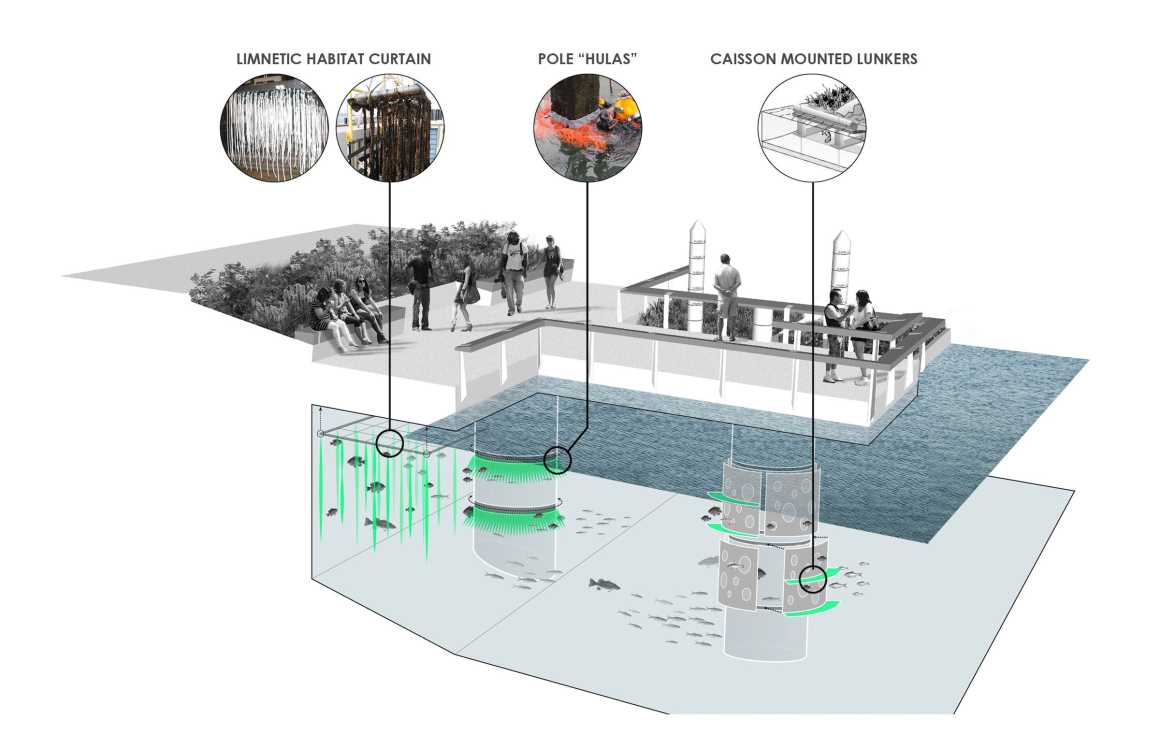
其中,位于州街与拉萨尔街之间的三个空间于2015年5月建成并开放。另外三个空间的施工与2015年夏季开始,于2016年10月完成。
The first three blocks, from State Street to LaSalle Street, were completed and opened to the public in May, 2015. The construction of the next three blocks began in summer 2015 and was completed in October 2016.
项目名称: 芝加哥滨河步道
项目位置: 美国伊利诺伊州芝加哥市
业主名称: 芝加哥市交通部
项目现状: 二期2015年5月开放
三期2016年10月开放
规模: 1.4公顷
服务范围:规划、城市设计、建筑、景观建筑、土木工程、平面设计
Project name: Chicago Riverwalk Expansion
Project location: Chicago, IL
Client name: Chicago Department of Transportation
Completion date: Phase Two, completed May 2015
Phase Three, completed October 2016
Size: 1.4 hectares
Services: Planning; Urban Design; Architecture; Landscape Architecture; Civil Engineering; Graphic Design
更多 Read more about:Sasaki


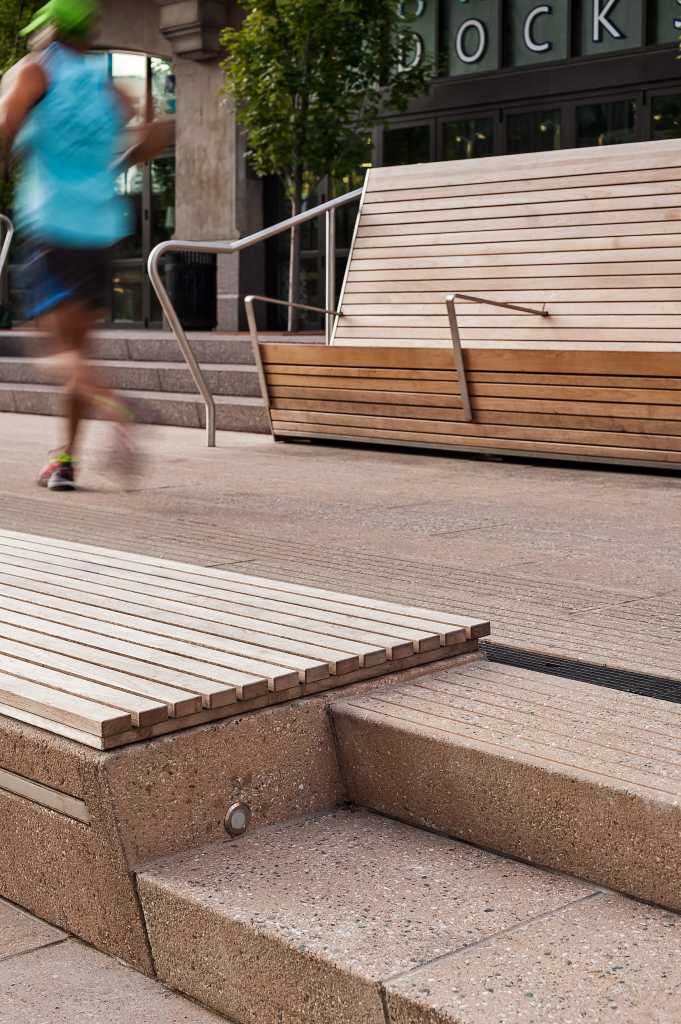
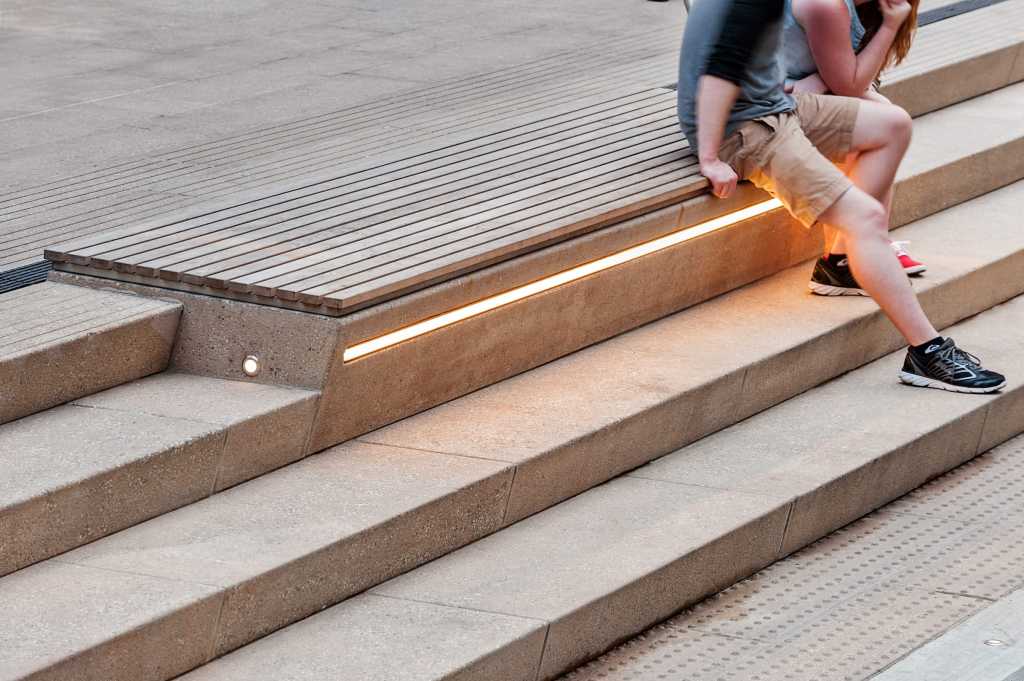






高度城市化过后,干净简洁背后依然有着人们对于生活的浪漫。